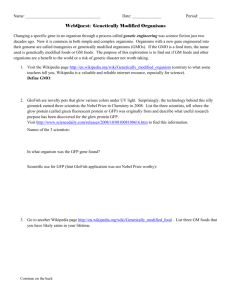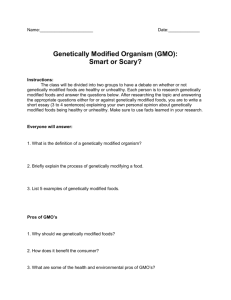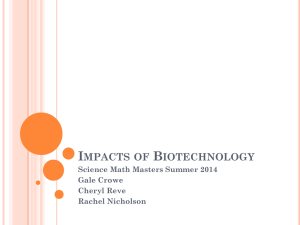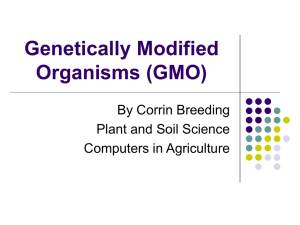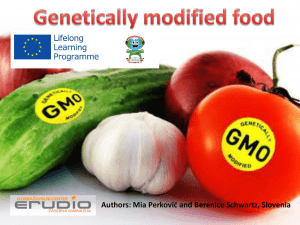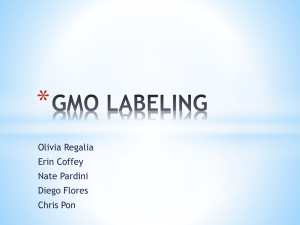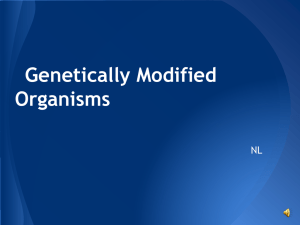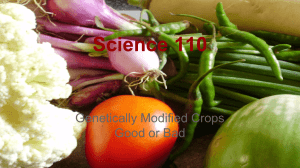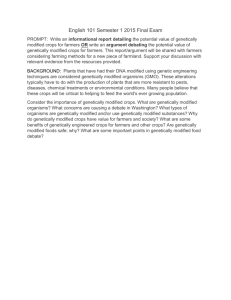The creation of Genetically Modified organisms, or GMO`s has
advertisement
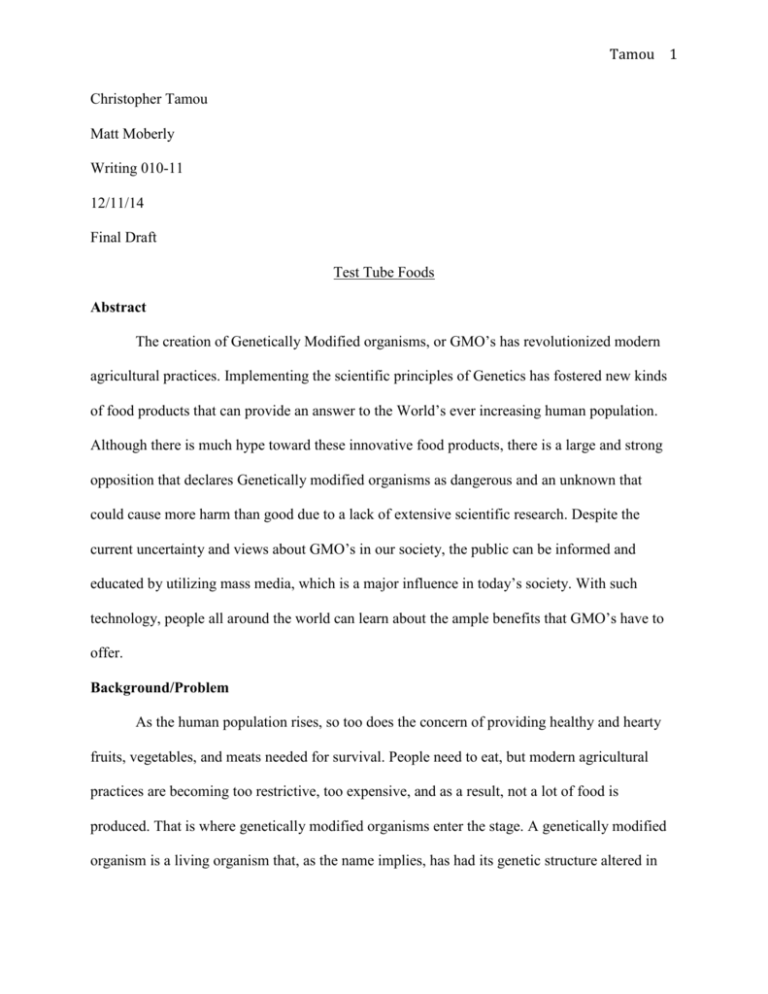
Tamou 1 Christopher Tamou Matt Moberly Writing 010-11 12/11/14 Final Draft Test Tube Foods Abstract The creation of Genetically Modified organisms, or GMO’s has revolutionized modern agricultural practices. Implementing the scientific principles of Genetics has fostered new kinds of food products that can provide an answer to the World’s ever increasing human population. Although there is much hype toward these innovative food products, there is a large and strong opposition that declares Genetically modified organisms as dangerous and an unknown that could cause more harm than good due to a lack of extensive scientific research. Despite the current uncertainty and views about GMO’s in our society, the public can be informed and educated by utilizing mass media, which is a major influence in today’s society. With such technology, people all around the world can learn about the ample benefits that GMO’s have to offer. Background/Problem As the human population rises, so too does the concern of providing healthy and hearty fruits, vegetables, and meats needed for survival. People need to eat, but modern agricultural practices are becoming too restrictive, too expensive, and as a result, not a lot of food is produced. That is where genetically modified organisms enter the stage. A genetically modified organism is a living organism that, as the name implies, has had its genetic structure altered in Tamou 2 some way. A genetically modified organism, or GMO, can be either a plant or an animal in which it’s genetic code, or genome, has been changed in some manner. Such a change is where confusion on these organisms starts. With the advances in the study of Genetics, scientist have been able to remove, or splice, the DNA of one organism such as a fish, a bacterium, or any other living thing and insert it into another organism. This causes a rearrangement in the organism’s genes, which changes the physical properties of that organism. A prevalent example of a genetically modified organism would be rice. As Susan Johnson, a writer and juris doctor candidate for the American University College of law, writes in her article “Genetically modified Food: A Golden Opportunity?” she talks about the creation of “Golden Rice”, a Genetically modified form of rice that has a higher nutritional content of vitamin A and beta-carotene (Johnson, 34-70). Such a food could be used to combat hunger in poor countries like Africa, preventing blindness and other nutrient-deprived diseases. These genes are altered in other foods to create new kinds of physical properties that are useful, such as more seeds inside plants, increased resistance to viral or insect infection, and a higher nutritional value. Such a practice is not as nuance as it seems. A quote from the professor of life sciences at Pennsylvania state university Nina Fedoroff’s article “Genetically Modified Foods Help the Environment” states “For thousands of years, farmers have been picking and choosing plants, propagating those with the genetic changes-mutations- that made them better food plants” (Fedoroff, 2003). As a result, GMO’s are but another revolutionary byproduct of human ingenuity and advancement. With all the good that GMO’s can provide, not everyone views them in the same regard. Opposition against genetically modified organisms’ has been great, with many social and political influences, which bolster their position. They claim that genetically modified organisms are worse substitutes due to the lack of knowledge about the potential health risks that they can Tamou 3 pose to human health, the reinforced strength of these foods against bacteria or insects can cause evolutionary changes that can make these harmful creatures even more of a threat to other crops, and the effects that these foods can have on the environment. A prime example would be the “Flavr Savr tomato”, the very first GMO ever commercially sold to consumers (Weiss, 875-914). Initially, the product was a hit with consumers and sold quite rapidly in the mid-1990’s. Unfortunately, near the end of the 1990’s, overall sales fell drastically for the GMO due to fears propagated by anti-GMO groups concerning their level of safety in regards to human health. As a result, the GMO was recalled and has not been sold in markets since. A quote from an article written by Vandana Shiva, the director of the research foundation of science, technology, and natural resource policy, called “Genetically Engineered Foods Should Not Be Produced” states “The myth of increasing yields is the most common justification for introducing genetically engineered crops in agriculture” (Shiva, 2000). They state that there is little research as to the validity of these foods in terms of safety and effectiveness in feeding them to the general masses. As a result of this strong and controversial debate, the general public seems to be at odds on the issue. On the one hand, GMO’s have the possibility of providing ample food supply for future generations while on the other hand they pose a threat to the modern agricultural ideals that have been engrained into our culture. This causes an impasse, as more and more people are clueless as to the severity of the issue. Without proper explanation of GMO’s from both sides, in terms of long-term answers to food hunger, many people, both nationally and internationally, would face the ever-encroaching threat of starvation. Solution Yet despite discussing GMO’s to the public, a solution that has been proposed is to ban GMO’s completely. Advocates of this solution believe that not only has there not been extensive Tamou 4 research performed on these foods, but that they cause more harm than good to other fields of society, mainly in the agricultural field. These groups also see GMO’s as an attempt by industrial leaders, such as Monsanto, to monopolize on the world’s food crisis by flooding the market with laboratory food products. Such a solution has been implemented in Europe. European governments restrict the importation of GMO’s from countries, such as the United States, and offer native farmers large subsidies so as to promote the production of more food. Reed Karaim, a writer and author of the book “If Men Were Angels”, wrote an article called “Farm Subsidies” which states “In Europe, there is more political and public support for payments, but early versions of the revised EU Common Agricultural Policy (CAP) focuses more on the “green” farming practices and limiting payments to large producers” (Karaim, 205-28). Europe attempts to maintain it’s “green thumb” by reducing all genetically modified foods from their markets by any means necessary. This solution also states that GMO’s could potentially harm the environment by introducing new and unknown genes that would pollute and spread around other crops. As stated by the opposition, GMO’s can cut subsidies from farmers and lower the amount of money they obtain from the government. This solution sees genetically modified organisms as unwanted and dangerous while imploring the need to bolster natural agricultural practices. The introduction of genetically modified organisms into our lives has had various responses among different groups. Another solution proposed in order for Genetically modified organisms to be accepted as an appropriate answer to human food problems, such as shortage of food, pest resistant crops, and so on, the public must understand the research that has gone into making these foods safe, effective, and useful by demonstrating the improved characteristics of the food products and labeling them on containers. A quote from Dr. Doris J. Rapp, a board certified doctor in Environmental Medicine, in her book “Our Toxic World”, she states “Regular Tamou 5 health food stores, Whole foods, and Trader Joes are anxious to have their products labeled because their customers are concerned” (Rapp, 2003) Also, the public must know how these organisms work in order to provide the necessary food and nourishment needed to sustain our lives. The solution to this is to publicize Genetically modified organisms via mass media. Using devices like the television or the radio, genetically modified foods can be explained to others in a clear and tangible way. Also, this allows further explanation by using real world examples as people may become interested in GMO’s and begin to see the full array of beneficial good that they are capable of. An example of this would be “golden rice” (Johnson, 34-70). This genetically modified form of rice was created so that poor countries, such as Somalia, India, and so forth would have ample nourishment and would evade starvation. Golden rice has a higher nutritional source of vitamin A and beta-carotene, both of which can prevent blindness and aid in providing ample food supply in these needy countries. An article written by Jon Entine, a writer on public policy and fellow at the American Enterprise Institute for Public Policy Research, called “Genetically Modified Foods Are Safe” states “Today in the Philippines, where 42% of the diet comes from white rice, a study by UN food expert estimates that “Golden Rice” could avert 879 deaths, 1,925 corneal ulcers, and 15,398 cases of night blindness each year” (Entine, 2003). The tarnished reputation on GMO’s has been propagated by the fear that they may cause bodily harm should they be consumed. As mentioned, there have been no incidences of illness or death when consuming GMO’s. As a result, these foods are a prime means of feeding not only ourselves, but the world as well. GMO’s can be elevated from their negative stigmas through the use of mass media in order to educate the public as to their resourcefulness, effectiveness, and meaningful uses. Tamou 6 The latter solution would be conscionable because it provides a realistic answer to the constant addition of humans into the world. It focuses on the dire need for ample food supplies to feed our growing human population. As our world becomes more crowded and more advanced, we must find new ways to grow food quickly and in high amounts. Without proper nutrition, many humans will die and continual loss of human life will ensue, resulting in a polarized spectrum of humanity with the technologically advanced countries progressing forward while less developed countries struggle for survival. In “Genetically Modified Food Should Not Be Banned, but Carefully Monitored”, an article written by lecturer of Ecology at the National University of Ireland, Maynooth Conor Meade, states “We are at the point now of testing coexistence strategies to see if they can work, but the only way we can really do it properly is to do controlled assessments in the field” (Meade, 13). Without discussing the uses of GMO’s, how can we be prepared for future food problems? The advocates of the anti-GMO solution neglect the imminent need for food in our world to resolve the pressing national and international problems. Conclusion With our world continually growing, so too does the need for food. Common agricultural methods that produce naturally grown crops are not abundant and cannot feed large populations, such as Europe. Genetically modified organisms are the answer in that more food can be produced, which in turn can feed more people and can be utilized in a more humanitarian approach. GMO’s are the key to a more prosperous future and yet without full and integrated acceptance of these foods there can be no progress. We must deliver a clear message to the public about genetically modified organisms by deciphering the false and slanderous ideals that have smeared their image and shed light on the positive effects of these foods. If we are to Tamou 7 provide a meal for all people, let it be based on the grounds of innovation, progress, and sustenance for all. Genetically modified organisms embody these aspects and act as the catalyst to spark a new “green revolution”, one that leads the way to a more contempt and satisfied world. Tamou 8 Works Cited Entine, Jon. "Genetically Modified Foods Are Safe." Genetically Engineered Foods. Ed. Nancy Harris. San Diego: Greenhaven Press, 2003. At Issue. Rpt. from "Debate: Genetically Modified Food and the WTO Ruling—Let Them Eat Precaution: What the WTO Decision on GMOs Really Means." Ethical Corporation (Apr. 2006). Opposing Viewpoints in Context. Web. 25 Oct. 2014. Fedoroff, Nina V. "Genetically Modified Foods Help the Environment." Genetically Engineered Foods. Ed. Nancy Harris. San Diego: Greenhaven Press, 2003. At Issue. Rpt. from "Genetically Modified Foods: Making the Earth Say Beans." Science Journal (Spring 2007). Opposing Viewpoints in Context. Web. 25 Oct. 2014. Johnson Susan. “Genetically Modified Food: A Golden Opportunity?.” Sustainable Development Law & Policy 14.1 (2014): 34-70. Academic Search Complete. Web. 25 Oct. 2014. Karaim, Reed. "Farm Subsidies." CQ Global Researcher 1 May 2012: 205-28. Web. 25 Oct. 2014. Meade, Conor. "Genetically Modified Food Should Not Be Banned, but Carefully Monitored." Genetically Engineered Foods. Ed. Nancy Harris. San Diego: Greenhaven Press, 2003. At Issue. Rpt. from "Careful Stewardship of GM Crops Is Needed, Not a Ban." Irish Times 23 June 2007: 13. Opposing Viewpoints in Context. Web. 25 Oct. 2014. Price, Tom. "Global Hunger." CQ Researcher 8 Aug. 2014: 673-96. Web. 25 Oct. 2014. Rapp, Doris. Our Toxic World: A Wake Up Call. Penryn: Personal Transformation Press, 2003. Print. Shiva, Vandana. "Genetically Engineered Foods Should Not Be Produced." Stolen Harvest: The Hijacking of the Global Food Supply. Cambridge, MA: South End Press, 2000. Rpt. in Tamou 9 Global Resources. Ed. Helen Cothran. San Diego: Greenhaven Press, 2004. Opposing Viewpoints. Opposing Viewpoints in Context. Web. 25 Oct. 2014. Weiss, Hilary. “Genetically Modified Crops: Why Cultivation Matters.” Brooklyn Journal Of International Law 39.2 (2014): 875-914. Academic Search Complete. Web. 25 Oct. 2014.
